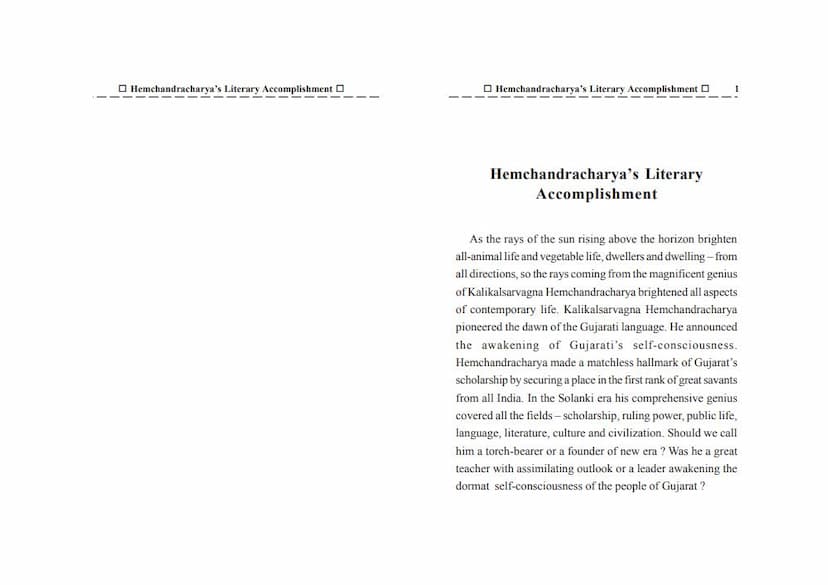Hemchandracharyas Literary Accomplishment
Added to library: September 1, 2025

Summary
This book, "Hemchandracharya's Literary Accomplishment" by Kumarpal Desai, is a detailed exploration of the vast and multifaceted literary contributions of Hemchandracharya, a renowned Jain scholar and polymath. The author presents Hemchandracharya as a pivotal figure who significantly shaped Gujarat's cultural and linguistic landscape, earning him the epithet "Kalikalsarvagna" (all-knowing of the current age).
The book highlights Hemchandracharya's impact on the nascent Gujarati language, fostering its self-consciousness and establishing it as a vehicle for scholarship. His genius is described as encompassing various fields, including literature, language, culture, philosophy, logic, and even practical sciences. He is praised for his unifying vision, respecting all religions and embodying the Jain principle of anekanta (multi-faceted truth).
Key aspects of Hemchandracharya's literary output detailed in the book include:
-
Grammar: His magnum opus, the Siddhahem Shabdanushasan, is presented as a groundbreaking work that revolutionized Sanskrit grammar and laid the foundation for Gujarati literature. It is lauded for its comprehensiveness, clarity, and systematic organization, even surpassing earlier grammarians like Panini in certain aspects. The book also details his significant contributions to Apabhramsha grammar, which is considered a precursor to modern Gujarati.
-
Dictionaries: Hemchandracharya compiled several essential Sanskrit dictionaries, including Abhidhanachintamani, Anekarthasamgrah, and Nighantushesa. He also compiled Deshinamamala, a crucial dictionary of vernacular words, which is vital for understanding the evolution of Gujarati and other Indian languages. These dictionaries are recognized for their scholarly depth and historical significance, preserving words and concepts that might otherwise have been lost.
-
Poetics and Prosody: His works Kavyanushasan (on poetics) and Chhandonushasan (on prosody) are discussed as comprehensive guides for understanding literary devices and poetic structures. While acknowledging the influence of earlier traditions, the book highlights Hemchandracharya's original contributions and his systematic approach to classifying figures of speech.
-
Epic Poetry: The book elaborates on his epic poems, particularly the Dvashraya, which serves a dual purpose: illustrating grammatical rules and narrating the history of the Chaulukya dynasty. This work is praised for its historical value, cultural insights, and its role in fostering Gujarat's identity. The Trisastisalakapurushacharitra, a monumental work detailing the lives of sixty-three great Jain figures, is presented as an encyclopaedia of Jain lore, history, and philosophy.
-
Logic and Philosophy: Hemchandracharya's expertise in logic is evident in his work Pramanamimansa (also known as Vadanushasan), which explores various schools of philosophical thought with a spirit of tolerance and intellectual rigor. His Yogashastra is highlighted as a practical guide to spiritual life, blending Jain ethics with yogic principles, and was particularly appreciated by King Kumarpal.
-
Devotional Literature: The book also touches upon his devotional hymns, such as Veetaragastotra, Ayogavyavachchhedikadvatrinshika, and Anyayogavyavachchhedikadvatrinshika, which showcase his deep philosophical understanding and profound devotion.
The author consistently emphasizes Hemchandracharya's holistic approach, his ability to connect diverse fields of knowledge, and his dedication to making learning accessible. He is portrayed not just as a scholar but as a cultural architect, a spiritual guide, and a catalyst for the Renaissance of Gujarat. The book concludes by underscoring Hemchandracharya's enduring legacy and his profound impact on the literature, language, and culture of Gujarat and India.